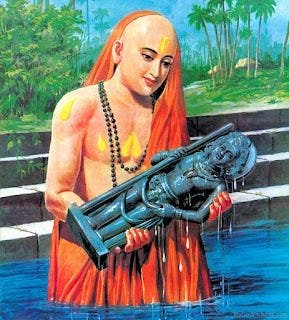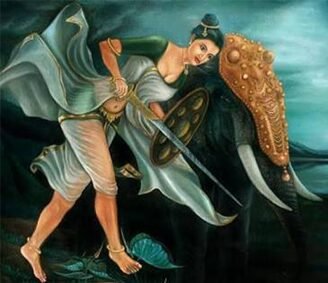Madhvacharya: Bridging Devotion and Philosophy in Hinduism

Madhvacharya was born in the 13th century near Udupi on the west coast of Karnataka, India. As a teenager, he became a Sanyasi (monk) and joined the Brahma-sampradaya under the guidance of Guru Achyuta Preksha. Madhvacharya’s philosophy is called Tattvavāda, emphasising realist viewpoints, He extended an independent, original system of thought within Vaishnavism, His teachings are built on the premise that there is a fundamental difference between Atman (individual soul) and the Brahman (ultimate reality, God Vishnu). According to Madhva, these are two distinct unchanging realities, with the individual soul dependent on Brahman but never identical.

Madhvacharya wrote commentaries on the Principal Upanishads, the Bhagavad Gita, and the Brahma Sutras (Prasthana Trayi), His writing style was concise and condensed, and his greatest work is considered to be the Anuvyakhyana, a philosophical supplement to his Bhasya on the Brahma Sutras, In some of his works, he proclaimed himself to be an avatar of Vayu, the son of god Vishnu. Madhva engaged in philosophical debates during his travels across India, He established the Krishna Mutt at Udupi, which remains significant to this day. His teachings continue to influence Hindu thought, emphasising the dualistic nature of reality and the relationship between the individual soul and the divine.

Madhvacharya established the Dvaita Vedanta sub-school within the broader Vedanta tradition of Hindu philosophy, Originally known as Tattvavada, this school emphasises realist viewpoints. The term Tattvavada literally translates to “arguments from a realist viewpoint.”. Madhvacharya’s profound contributions shaped the foundation of this philosophical system.
According to Dvaita Vedanta, there are three fundamental entities:
God (Vishnu or Narayana)
Jiva (individual soul)
Jada (maya or matter)
Madhvacharya asserted that these entities exist as independent realities:
God is independent (svatantra).
Souls are dependent (paratantra) on God.

The Dvaita school contrasts with other major Vedanta sub-schools:
Advaita Vedanta (by Adi Shankara) posits nondualism, where ultimate reality (Brahman) and the human soul (Ātman) are identical. Vishishtadvaita (by Ramanuja) posits qualified nondualism, acknowledging the potential identity between Brahman and the soul, Madhvacharya’s teachings continue to resonate within Hindu thought, He engaged in philosophical debates and established the Krishna Mutt at Udupi, a significant pilgrimage site, His emphasis on the dualistic nature of reality left an indelible mark on the understanding of the relationship between the individual soul and the divine.
As a young teenager, Madhvacharya took a profound spiritual path and renounced worldly life and embraced the life of a Sanyasi (monk) under the guidance of his guru, Achyutapreksha, who belonged to the Brahma-sampradaya of the Ekadandi order.

Madhvacharya delved into the study of Hindu philosophy, immersing himself in the classics. His scholarly pursuits led him to write commentaries on essential texts such as the Principal Upanishads, the Bhagavad Gita, and the Brahma Sutras (Prasthana Trayi). His writing style was characterised by brevity and condensed expression, and his work Anuvyakhyana stands out as a philosophical supplement to his Bhasya on the Brahma Sutras. Madhvacharya’s teachings continue to resonate within Hindu thought. He established the Krishna Mutt at Udupi, a revered pilgrimage site that remains significant to this day. His emphasis on the dualistic nature of reality and the relationship between the individual soul and the divine left an indelible mark on Hinduism.

At the tender age of eleven, young Vasudeva completed his Sanskrit studies. Driven by a deep longing for spiritual realisation, he sought a guru who could initiate him into the renounced order of life. Remarkably, even at the age of five, he had already received initiation into the brahminical (priestly) order., Madhvacharya found his spiritual guide in Achyuta Preksha, an Advaitin monk, at Udupi. Under Achyuta Preksha’s guidance, Vasudeva underwent the sacred diksha (initiation) into sannyasa. The ochre-coloured robes symbolised his renunciation of worldly attachments and his commitment to a life dedicated to spiritual pursuits.

The sannyasa ceremony involves several transformative steps. Fasting, silence, Japa (repetition of sacred mantras), and meditation for five days. Shaving of the head, signifying detachment from external appearances. A series of ritual steps (tarpanam), symbolising the cutting of all worldly relations and the final performance of obligatory duties. On the penultimate day, the newly initiated sannyasis perform tarpanam, expressing gratitude to all living beings, ancestors, and Rishis, thus severing ties with the material world.
Madhvacharya participated in the Viraja Homa, a sacred fire ceremony, behind closed doors. In this private ceremony, he received his ochre robes and a new name—an integral part of the ancient tradition. Thus, he became ordained into the most ancient monastic lineage of great sages and monks. His life’s purpose now centred on liberation and uplifting the world, as envisioned by the Vedas and his initiation into sannyasa marked a turning point in his life. He established the Krishna Mutt at Udupi, where his teachings continue to inspire seekers. His unwavering commitment to spiritual realisation and his emphasis on alertness, love, and faith left an indelible mark on Hinduism also he wrote commentaries on the Principal Upanishads, which are foundational texts in Hindu philosophy. These Upanishads explore profound metaphysical and spiritual concepts, including the nature of reality, the self (Atman), and the ultimate truth (Brahman). His commentaries provided insights into the dualistic perspective, emphasising the distinctness of God and individual souls. The Bhagavad Gita, a revered scripture, contains a dialogue between Lord Krishna and the warrior prince Arjuna on the battlefield of Kurukshetra. Madhvacharya’s commentary on the Gita elucidated its teachings, emphasising devotion, duty, and the path to liberation. His interpretation highlighted the dualistic relationship between the individual soul (jiva) and the Supreme Lord (Bhagavan). The Brahma Sutras, also known as the Vedanta Sutras, systematise the doctrines taught in the Upanishads and the Gita.

Madhvacharya’s bhāṣya (commentary) on the Brahma Sutras provided a unique perspective within the Vedanta tradition. His writings emphasised the dualistic nature of reality, asserting the eternal distinction between God (Vishnu) and individual souls (Jivas).
His commentaries continue to inspire scholars, seekers, and devotees. His concise and precise writing style, coupled with his unwavering commitment to theistic philosophy, enriched Hindu thought. Through his works, he left a lasting legacy, emphasising devotion, knowledge, and the pursuit of truth he fiercely contested the teachings of Adi Shankara’s Advaita Vedanta. While Advaita emphasised nondualism (the identity of the individual soul and Brahman), Madhvacharya asserted the distinctness of God (Vishnu) and individual souls (Jivas). His arguments centred on the eternal separation between these two realities. Madhvacharya also challenged Ramanuja’s Vishishtadvaita Vedanta. Vishishtadvaita posits qualified nondualism, acknowledging a potential identity between Brahman and the soul. Madhvacharya’s dualistic stance emphasised the eternal difference between God and souls. Madhvacharya fearlessly debated scholars from various traditions, including Buddhism and Jainism. His keen and irrefutable logic left many opponents defeated. His writings systematically dismantled opposing viewpoints, establishing the foundations of his own school of thought, Madhvacharya’s unwavering commitment to his dualistic philosophy continues to inspire seekers His emphasis on devotion, knowledge, and the pursuit of truth left an indelible mark on Hinduism His debates were not mere intellectual exercise they shaped the course of Hindu thought and theology.

In the 13th century, Shri Madhvacharya, a Vaishnavite saint and the founder of the Dvaita school of Vedanta, established the Udupi Sri Krishna Temple. His vision was to create a spiritual haven for devotees, emphasising devotion, knowledge, and the pursuit of truth.
The idol of Lord Krishna is adorned with a golden chariot and jewels, radiating divine grace. However, the process of worship and prayers takes place solely through a silver-plated window called the Navagraha Kitiki. This window has nine holes, symbolising the nine planets (Navagrahas). Devotees offer their prayers, flowers, and offerings through these holes, maintaining a sacred distance from the deity. The worship through the Navagraha Kitiki reinforces the eternal distinction between God (Vishnu) and individual souls (Jivas).

The temple area resembles a living ashram, fostering a holy place for daily devotion and living. Devotees gather to witness the divine darshan (sight) of Lord Krishna through the silver window. The Udupi Sri Krishna Temple is not just a place of worship; it’s a spiritual sanctuary where seekers connect with the divine. The temple remains an important religious centre for followers of the Dvaita Vedanta Hindu philosophy. It is also the birthplace of Dasa Sahitya, a unique form of literature associated with devotional songs and compositions. Pilgrims visit Udupi from far and wide to seek blessings and experience the sacred ambiance of this revered temple.
Madhvacharya’s teachings inspired a lineage of devoted followers who continued to propagate his philosophy. His disciples, such as Jayatirtha, Sripadaraja, Vyasatirtha, Vadiraja Tirtha, Raghuttama Tirtha, Raghavendra Tirtha, and Satyanatha Tirtha, followed in his footsteps, Each of these scholars contributed to the preservation and dissemination of Dvaita Vedanta, carrying forward Madhvacharya’s legacy, Madhvacharya travelled extensively across India, visiting sacred places and engaging in philosophical debates, His teachings reached far and wide, influencing seekers, scholars, and devotees.

The establishment of the Krishna Mutt at Udupi became a focal point for the propagation of Dvaita philosophy. His emphasis on devotion, knowledge, and the eternal distinction between God and individual souls resonated with spiritual seekers.
In an era where materialism and scepticism abound, his focus on personal connection with God provides solace and purpose. Madhvacharya’s Dvaita Vedanta asserts the eternal distinction between God (Vishnu) and individual souls (Jivas). This dualistic perspective offers an alternative to monistic philosophies, emphasising divine love and service. His establishment of the Udupi Sri Krishna Temple exemplifies practical spirituality. The unique worship through the Navagraha Kitiki (silver window) allows devotees to connect with the divine in a simple yet profound manner, Madhvacharya’s writings, commentaries, and temple rituals continue to inspire millions.
His eternal relationship between the finite soul and the infinite God remains timeless.


